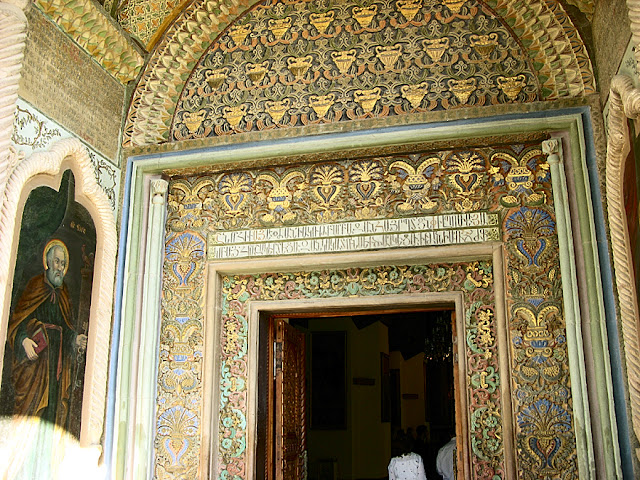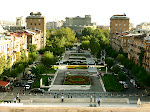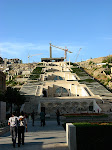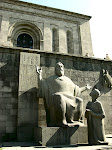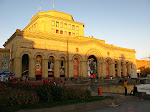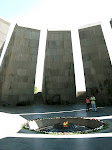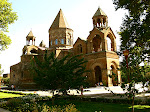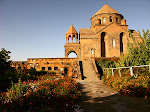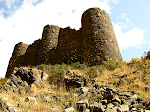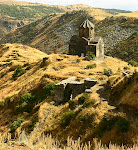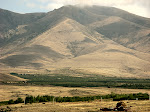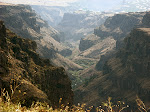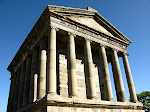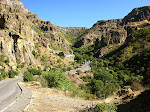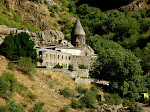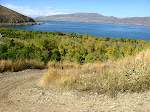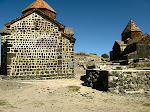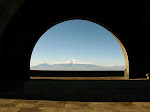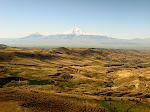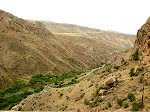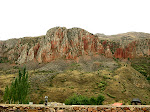![]() EN
EN
Main Entrance to the Mayr Tachar Church, Echmiadzin, Armenia.
Armenia is a republic of the Former Soviet Union, sandwiched in between Turkey, Iran, the Republic of Georgia, and Azerbaijan. It is small, about the same size as my home state of Maryland, or Belgium, and not that well-known in the USA. It has a language that is unusual, with a unique alphabet. The people are very friendly, and the food is fresh and tasty. Truly a unique gem, and I have made some friends there.
Armenia was the first country to officially become Christian in the world, around 301 AD. The Armenians built many of their churches in the mountains or on cliffs above canyons. The country is mostly high-altitude and dry. The capital, Yerevan is a modern city with museums, galleries, and monuments, and beautiful views from the surrounding heights. Have a look at this remarkable country! I took two trips here, in the Fall of 2008 and Fall of 2009.
Yerevan
Yerevan is the capital of Armenia, and is fairly close to the closed border with Turkey. It was first founded as the fortress of Erebuni about 70 years before Rome was founded (the Erebuni fortress is in the southeast corner of the modern city). It is a high city, which is surrounded by hills on all sides. It has some impressive buildings and museums, thousands of street cafés and a laid-back atmosphere. People tend to stay out late, restaurants and bars are open late, too.
First row, left to right: Skyline of Yerevan, with Mt. Ararat in the background; Spendiarou Opera and park; Kaskad (Cascade), with World War II Memorial at the top.
Second row, left to right: Matenadaran (National Archive), with statue of Mesrop Mashtots, inventor of the Armenian Alphabet; National Museum, Republic Square; Eternal Flame, Tsitsinakaberd Armenian Genocide Memorial.
Echmiadzin
Echmiadzin is a town just west of Yerevan, and is famous for its churches. It is the spiritual center for all Armenians, because this is where the Armenian Apostolic Church has its headquarters. The Armenian Church is independent, and Echmiadzin is the Armenian equivalent of the Vatican for Catholics. It is a very pleasant town to stroll through and admire the ancient churches!
First row, left to right: Mayr Tachar (Mother Church of Armenia); Surp Hripsime Church.
Second row, left to right: Surp Gayane Church; Shoghakat Church.
Aragats
Aragats is the largest mountain in modern-day Armenia, and the region it is part of is called Aragatsotn (“foot of Aragats”), and is just northwest of Yerevan. There are some gorgeous churches and monasteries here, on the lower slopes of Mt. Aragats. This is a region of natural beauty and historical significance.
First row, left to right: Amberd Fortress; St. Astvatsatsin Church, next to Amberd Fortress; view of Mt. Ararat from Mt. Aragats.
Second row, left to right: Mt. Ara; Mt. Ara and canyon; view of canyon from Mt. Aragats area.
Garni and Geghard
Garni is an ancient temple and summer palace right near Yerevan. Geghard is a monastery in the same area with caves where the monks lived. Both are also in dramatic settings.
First row, left to right: Garni Temple; the approach to Geghard Monastery.
Second row, left to right: Geghard Monastery; cave dwellings for monks at Geghard.
Lake Sevan
This is the largest lake in Armenia, and is about one hour northeast of Yerevan. Check out the Sevanavank Monastery, perched in the heights above the lake, too!
First row, left to right: Lake Sevan; Sevanavank Monastery.
Second row, left to right: carved wooden door at Sevanavank Monastery; mountains on the other side of Lake Sevan.
Mt. Ararat Area
Mt. Ararat is just over the border in Turkey, but it is visible from much of Armenia, as you no doubt have already noticed. Take a look at these photos of the holy mountain from Armenia, including the ones in and around Khor Virap Monastery, which is right on the Turkish border and literally in the shadow of the mountain.
First row, left to right: view of Mt. Ararat through the Charents Arch (named for Yeghishe Charents, the Armenian poet who spent time here and wrote about the view in his poems); view of Mt. Ararat on the way out of Yerevan. Mt. Ararat is, of course, the place that the Bible says that Noah’s Ark landed after the Deluge. It is a holy symbol for the Armenian people. It now lies within Turkey. On one spot in the shadow of Mt. Ararat, legend says that the Christian missionary St. Gregory the Illuminator was imprisoned in a snake pit by King Trdat for years, until Trdat was scared into becoming Christian (the accounts of this vary, some say he was temporarily changed into a boar). After Trdat became Christian and declared Armenia a Christian country in 301, the Khor Virap Monastery was built on the spot where this happened. Gregory was set free and became the first head of the Armenian Church.
Second row, left to right: Khor Virap Monastery, by the Turkish border; view of Mt. Ararat from Khor Virap (you can see the Turkish army base at the foot of the mountain.
I also shot this video at Khor Virap Monastery. It was cloudy that day, but I took a guided tour there. It is possible to buy pigeons at the monastery and then set them free–the legend says that they will fly back to Mt. Ararat.
Vayots Dzor
Vayots Dzor (“The Gorge of Woes”) is a very long, barren canyon region southeast of the Ararat region and Yerevan. It gets its name from the sorrow that it brought to many families due to earthquakes that killed many people a long time ago. This desolate area boasts the Noravanq Monastery, which is perched above the gorge.
Left to right: Noravanq Monastery; view of Voyots Dzor canyon from Noravanq; rock formations around Noravanq.
Dilijan
The area around Dilijan is more forested, and is called the “Armenian Switzerland”. This video will give you a good idea, because I took it on the tour bus going from Dilijan back to Lake Sevan, on the road back to Yerevan. As we passed through the tunnel, we went from the lush, forested area of Dilijan, to the dry and barren area around Sevan. I think it’s a fascinating contrast.
Please feel free to check out my Armenia photo gallery, which has many more photos and also a slideshow! In the gallery, you may click on the button in the upper right labeled “Lightbox View”, to see it as a slideshow.

